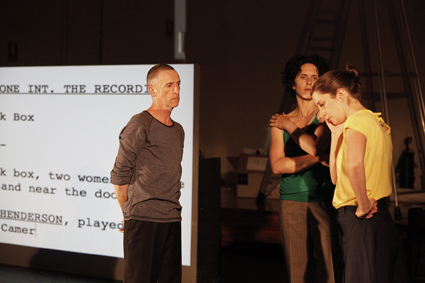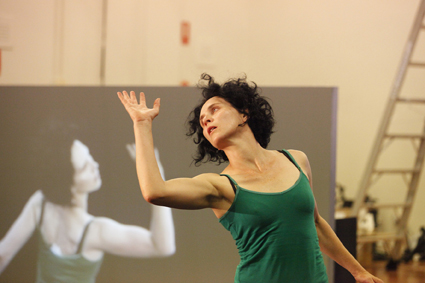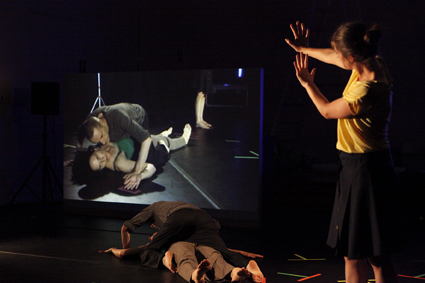dance massive 2013
March 27 2013
dance: installed, immersed, hybridised
keith gallasch: dance massive 2013
quotidian moves, gangnam-style
philipa rothfield: ben speth, wetubelive
dance massive 2013
sounds to dance to, with, against
gail priest: sound design in dance massive 2013
March 26 2013
the life in the work
philipa rothfield: tracie mitchell, dance screen retrospective
youtubing live
varia karipoff: ben speth, wetubelive
dance massive 2013
March 24 2013
dance & disorientation
keith gallasch: tim darbyshire, more or less concrete
more or less monstrous
jana perkovic: atlanta eke, monster body
realtime tv: tim darbyshire, more of less concrete, dance massive 2013
March 22 2013
ritual entwining
philipa rothfield: soo yeun you, [gu:t] [work-in-progress]
strange affliction: dance massive & transcendence
keith gallasch: jo lloyd, future perfect
March 21 2013
a not so private hearing
carl nilsson-polias: tim darbyshire, more or less concrete
realtime tv: antony hamilton, black projects 1& 2, dance massive 2013
something ends, something begins
virginia baxter: dance exchange, dance for the time being - southern exposure
dance massive 2013
the perfection of submission
varia karipoff: jo lloyd, future perfect
March 20 2013
inner fury, seductive skill
philipa rothfield: anouk van dijk, chunky move, 247 days
March 20 2013
old tropes & the new disconnect
carl nilsson-polias: lucy guerin inc & belvoir, conversation piece
March 19 2013
now, then, now
keith gallasch: sandra parker, the recording
realtime tv: anouk van dijk, 247 days, chunky move, dance massive 2013
dance massive 2013
March 18 2013
creating an affective community
jana perkovic: matthew day, intermission
fun and the damage done
keith gallasch: larissa mcgowan, skeleton
more than smoke and mirrors
virginia baxter: ashley dyer, life support
realtime tv: lee serle, p.o.v., dance massive 2013
March 17 2013
realtime tv: dalisa pigram, gudirr gudirr, dance massive 2013
the body un-mirrored
jana perkovic: anouk van dijk, chunky move, 247 days
the origins of feeling
philipa rothfield: sandra parker, the recording
March 16 2013
realtime tv: stephanie lake, dual, dance massive 2013
dance massive 2013
March 15 2013
a dance for dark times
virginia baxter: dalisa pigram, gudirr gudirr
brittle bones & internal electricity
carl nilsson-polias: larissa mcgowan, skeleton
in the thick of it
philipa rothfield: lee serle, p.o.v.
March 15 2013
inside the audience
jana perkovic: lee serle, p.o.v
the poetry of pain
keith gallasch: stephanie lake, dual
dance massive 2013
when two become one
varia karipoff: stephanie lake, dual
March 14 2013
blacker than black
keith gallasch: antony hamilton, black projects 1 & 2
life in a puff
carl nilsson-polias: ashley dyer, life support
March 13 2013
dark symmetries
carl nilsson-polias: antony hamilton, black projects 1 & 2
lines of flight
philipa rothfield: dalisa pigram, gudirr gudirr
dance massive 2013
suggestive formalism
jana perkovic: natalie abbott, physical fractals
unsettling the audience
varia karipoff: natalie abbott, physical fractals
February 22 2013
an intense manifestation of dance
philipa rothfield: dance massive 2013, melbourne
dance massive 2013: from the archive
lucy guerin inc, conversation piece; antony hamilton, black project; atlanta eke, this monster body; matthew day, intermission; jo lloyd, future perfect; tim darbyshire, more or less concrete; natalie abbot, physical fractals; ben speth, wetubelive
 |
Trevor Patrick, Fiona Cameron, Phoebe Robinson, The Recording, Sandra Parker
photo Rachel Roberts |
THE CHALLENGE TO DEVELOP A CONCEIT INTO A FULLY EMBODIED AND THEMATICALLY RICH IMAGE IS ALWAYS CONSIDERABLE. SANDRA PARKER RAMPS UP THE DISJUNCTION BETWEEN LIVE PERFORMANCE AND WHAT WE SEE ONSCREEN VIA CAMERA AND AMPLIFIES THE DIFFERENCE BY JUXTAPOSING MINIMALLY EXPRESSIVE MOVEMENT WITH MAXIMALLY EVOCATIVE MUSIC. HOW FAR CAN SHE TAKE THESE DISJUNCTIONS TO YIELD A MEANINGFUL EXPERIENCE?
The Recording is located on a film set (of which the audience, as in a TV show recording, are part) where three performers act out non-verbal expressions and actions in a series of takes, in between which they act at checking their scripts, mingling and rehearsing while technicians adjust lighting and camera positions. Initially, the un-contexualised actions, projected script fragments, Fiona Cameron’s sudden crawl across the floor and Trevor Patrick’s rejection of her subsequent intimate movement towards him are intriguing, building a sense of anticipation and some amusement at the vacuity of the spare gestures and ‘looks.’
The third performer, Phoebe Robinson, is positioned for a head and shoulders close-up, looking vaguely anxious, running her fingers repeatedly across her face or wiping her nose. As with all close-ups the audience can project emotions which are usually confirmed by context, but there’s little here save music. Robinson’s whole-body, off-screen self is a little more revealing, appearing gesturally assertive with someone we can’t see. The disjunction between images actual and virtual is sparely felt. While Robinson rehearses a set of moves the music develops a more potent sense of presence, its western idiom, bordering on movie music enriched with a kind of shakuhachi screech and pounding woodblocks—all very much at odds with what we are seeing.
 |
Fiona Cameron, The Recording, Sandra Parker
photo Rachel Roberts |
During a set-up for a scene, Trevor Patrick delivers lines deadpan to Robinson in rehearsal. We can barely hear them, but a few leak through: “I thought it would be much more fun,” and some reference to danger. But we never see or hear these words filmed. A scene with Cameron in close-up, appearing concerned and frustrated, and gesturing emphatically before the camera, signals little at great length, feeling too close in production manner to the preceding Robinson episode, while the almost progressive rock score is worlds away from these small moves. The gap between affect and effect grows even more disjunctive when the sound score grabs snatches of Hollywood TV crime shows and soaps—“The DNA results are in. The kid’s all mine”—juxtaposing them with a massively swelling score a la Angelo Badalamenti for David Lynch, while the trio executes abstracted actions, comic even, for example Patrick flicking his head as if slapped.
In a third of the close-up series, instead of seeing the performer’s head on a large screen, we instead watch Patrick standing next to the small monitor on which he appears, but for which he has been pre-recorded, slipping a little in and out of synch with himself in a further erosion of the connection between real and virtual. However, this take does have some sense of progression as Patrick eventually moves a hand to his forehead and finally hangs his head as if defeated. Robinson and Cameron on the other hand appear to pretty much have repeated their moves. By now I’m not convinced that the three ‘portraits’ are at all telling, let alone significantly different between stage and screen versions. There is nothing idiosyncratic in the movement, nothing particularly subtle, very little that requires anything of dancers as skilled as this trio, save their restraint.
If this is a work about what is lost in the recapturing of movement, there’s not much in The Recording that hasn’t already been repeatedly captured, as the choreographer writes, by her use of “a movement vocabulary literally drawn from film and television, a strategy to present embodied movement we instinctually recognise and feel comfortable watching” (Parker, “Capturing the live moment, The Recording,” Dancehouse Diary, Issue 4, March-June, 2013).
 |
Trevor Patrick, Fiona Cameron, Phoebe Robinson, The Recording, Sandra Parker
photo Rachel Roberts |
A near final scene has Cameron and Patrick struggling with each other, Cameron falling to the floor and Patrick on top of her. There are multiple, tedious re-takes without variation while Robinson stands to one side. When the couple fall on the stage floor, she is left alone on the screen, as if we are to identify with her. Cameron then repeats the fall by herself, perhaps like ‘the body’ in a thriller. Finally our attention is focused on Robinson in a spare solo, hands wandering to face again, performing to a fractured song featuring the repeated word “amour” (somewhat in the manner of Brazilian New Yorker Arto Lindsay). Perhaps there’s some kind of narrative we might feel inclined to fill in between the abstracted moves and a loaded sound score (couple at odds, one person kills/wounds the other, third party feels abandoned) but that doesn’t seem to be the point, nor my inclination. Rather, in The Recording, specificity is eschewed as abstracted expressions, gestures and moves are played out in a thinly suggestive and largely affectless scenario which is ‘captured’ on screen.
There is a certain attractive delicacy of expression in The Recording and a tonal consistency that refuses the emotions suggested by the multilayered score. However, the calculated emptiness of the action and the floating signification of the music (albeit very engaging in itself) yields an unsatisfying, double sense of absence. Is there anything at all dialectical being played out between the work’s clichéd movement and its sonic material, and between the stage and screen images? The difference between body on stage and head on screen is not especially revealing. Nor do the restricted movements of the dancers signal a richer stage life than the camera evokes. The Recording cannot therefore mount a strong argument for the immediacy of movement/dance/acting over mediatised versions.
In her Dancehouse Diary essay Parker repeats the much-cited Peggy Phelan and Andre Lepecki theses from the mid-1990s about the impossibility of documentation and re-presentation being able to generate meaningful versions or experiences of original performances. These have assumed a precious, metaphysical absolutism accompanied by a mantra of ‘now, now, now.’ But what kind of ‘now’? The raw immediacy of live dance before an audience, as felt in, say, Natalie Abbott’s Physical Fractals or Stephanie Lake’s Dual, however much rehearsed and repeated? A ‘now’ that has moved well beyond film and television images when media technologies, popular culture and notions of the real and the now have radically mutated? A reified sense of the ‘now,’ is not helpful in this context. There’s no denying the power of live dance but paranoia about losing its immediacy to inimical media forces is the least of its worries. Sandra Parker’s The Recording left me guessing, and argumentative.
Co-incidentally, the reproduction issue is bound to be debated in Sydney when Kaldor Public Art Projects launches 13 Rooms in Sydney’s vast Wharf 2/3 (April 11-23). The show comprises recreations of performances and installations originally created and/or peformed by Marina Abramovic, John Baldessari, Joan Jonas, Damien Hirst, Tino Sehgal, artist duo Allora and Calzadilla, Simon Fujiwara, Xavier Le Roy, Laura Lima, Roman Ondák, Santiago Sierra and Xu Zhen. 140 local dancers and performers have been employed to realize the works. There’s one new work, by Brisbane performance duo Clark Beaumont.
The Recording, director, choreographer Sandra Parker, dancers Fiona Cameron, Trevor Patrick, Phoebe Robinson, lighting design Jenny Hector, projection designer Rhian Hinkley, composer, sound designer Steve Heather; Dancehouse, Melbourne, March 13-16; http://dancemassive.com.au
© Keith Gallasch; for permission to reproduce apply to [email protected]
Back to top











 back
back